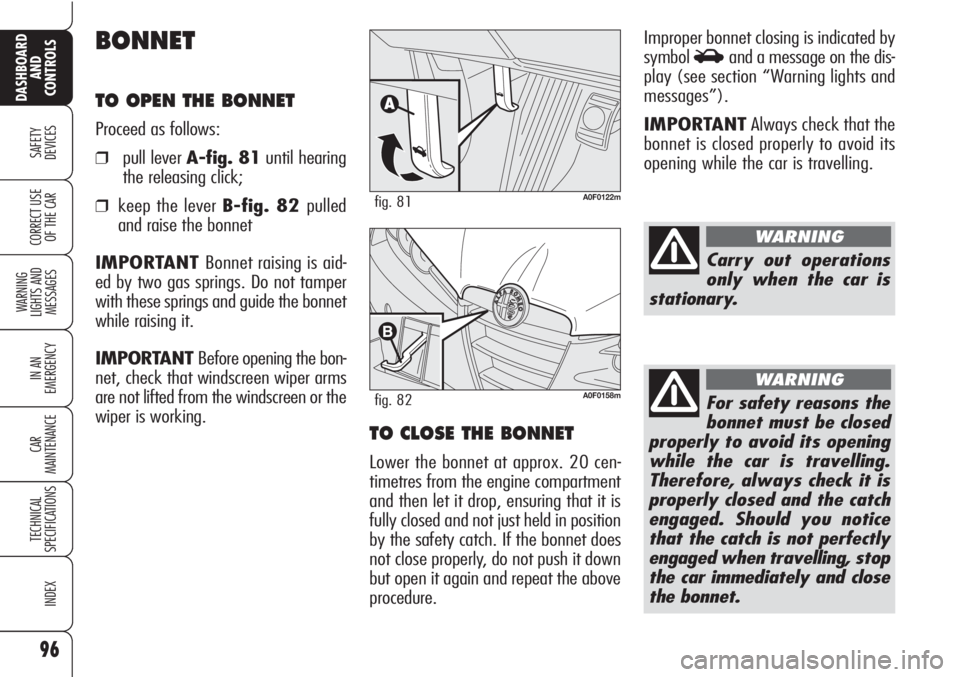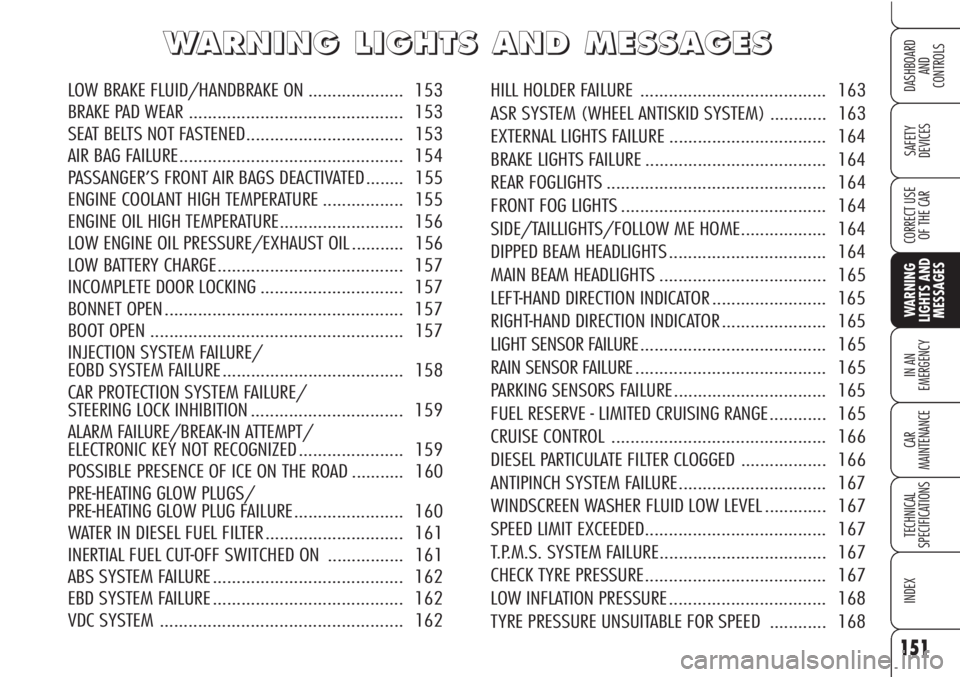2010 Alfa Romeo Brera/Spider open bonnet
[x] Cancel search: open bonnetPage 9 of 271

7
SAFETY
DEVICES
WARNING
LIGHTS AND
MESSAGES
IN AN
EMERGENCY
CAR
MAINTENANCE
TECHNICAL
SPECIFICATIONS
INDEX
DASHBOARD
AND
CONTROLS
CORRECT USE
OF THE CAR
DASHBOARD
A0F0056mfig. 1
1.Adjustable and swivel side air vents - 2.Front side window demisting/defrosting vents - 3.External lights control lever
-4.Instrument panel - 5.Driver’s air bag and horn - 6.Windscreen wiper control lever - 7.Upper central vent - 8.Ad-
justable and swivel central air vents - 9.Fuel level gauge/engine coolant temperature gauge/engine oil temperature gauge
(petrol versions) or turbocharger pressure gauge (diesel versions) - 10.Passenger’s air bag - 11.Passenger’s knees air
bag (for versions/markets, where provided) - 12.Glove box - 13.Sound system - 14.Heating/ventilation/climate con-
trols - 15.EngineSTART/STOPbutton - 16.Ignition device - 17.Driver’s knees air bag - 18.Sound system controls
on the steering wheel
(for versions/markets, where provided)-19.Cruise Control lever (for versions/markets, where provided)-
20.Bonnet opening lever - 21.Dashboard fusebox lid - 22.Switches for external lights, trip meter reset and headlamp aim-
ing device.
Page 19 of 271

17
SAFETY
DEVICES
WARNING
LIGHTS AND
MESSAGES
IN AN
EMERGENCY
CAR
MAINTENANCE
TECHNICAL
SPECIFICATIONS
INDEX
DASHBOARD
AND
CONTROLS
CORRECT USE
OF THE CAR
Depending on the markets, the trigger-
ing of the alarm will activate the siren
and the hazard warning lights (for about
26 seconds). The methods of operation
and the number of cycles may vary de-
pending on the versions/markets.
A maximum number of sound/sight cy-
cles is however envisaged. Once the
alarm cycle is over, the system will re-
store its normal operation.
IMPORTANTCentral door unlocking
by the emergency electronic key will not
deactivate the alarm, therefore with
alarm on the siren will activate when
opening one of the doors or the boot.
To deactivate the siren see paragraph
“How to deactivate the alarm”.
IMPORTANTThe engine immobiliser
function is guaranteed by the Alfa
Romeo CODE system, which is auto-
matically activated when the electronic
key is removed from the ignition device.
HOW TO ACTIVATE
THE ALARM
With the doors, bonnet and boot shut
and electronic key removed from igni-
tion switch, point the electronic key in
the direction of the car, then press and
release the button
Á.
With the exception of certain markets,
the system sounds a “beep” and the
doors are locked.
Engagement of the alarm is preceded
by a self-diagnostic test characterised by
a different flashing of the driver’s door
ledA-fig. 11: if a fault is detected the
system sounds a further warning
“beep”.
ALARM
(for versions/markets, where provided)
WHEN THE ALARM
IS TRIGGERED
The alarm comes into action in the fol-
lowing cases:
❒unlawful opening of doors, bonnet
and boot (perimetral protection);
❒attempt to start the engine with
unauthorised electronic key;
❒battery cable cutting;
❒presence of moving bodies in the
passenger’s compartment (volu-
metric protection);
❒abnormal raising/sloping of the car
(for versions/markets, where pro-
vided);
Volumetric and anti-raising protections
can be cut off by operating the front ceil-
ing light controls(see paragraph “Volu-
metric protection/Anti-raising sensor”
on the following pages).
A0F0034mfig. 11
Page 81 of 271

79
SAFETY
DEVICES
WARNING
LIGHTS AND
MESSAGES
IN AN
EMERGENCY
CAR
MAINTENANCE
TECHNICAL
SPECIFICATIONS
INDEX
DASHBOARD
AND
CONTROLS
CORRECT USE
OF THE CARResetting the power supply
cut-off switch
(for versions/markets,
where provided)The switch is located inside the fuse box
at battery positive terminal.
To reset the power supply cut-off switch,
proceed as follows:
❒press button A-fig. 53to reset the
fuel cut-off switch;
❒open the bonnet;
A0F0126mfig. 54
Before resetting the
power supply cut-off
switch carefully inspect the car
for fuel leaks or damages to
electric devices (e.g. head-
lights).
WARNING
A0F0071mfig. 55
❒operate the retaining clips A-fig.
54and remove the protection cov-
erB;
❒press buttonC-fig. 55to reset the
power supply.
Page 98 of 271

96
SAFETY
DEVICES
WARNING
LIGHTS AND
MESSAGES
IN AN
EMERGENCY
CAR
MAINTENANCE
TECHNICAL
SPECIFICATIONS
INDEX
DASHBOARD
AND
CONTROLS
CORRECT USE
OF THE CAR
BONNET
TO OPEN THE BONNET
Proceed as follows:
❒pull lever A-fig. 81until hearing
the releasing click;
❒keep the lever B-fig. 82 pulled
and raise the bonnet
IMPORTANT Bonnet raising is aid-
ed by two gas springs. Do not tamper
with these springs and guide the bonnet
while raising it.
IMPORTANT Before opening the bon-
net, check that windscreen wiper arms
are not lifted from the windscreen or the
wiper is working.A0F0122mfig. 81
A0F0158mfig. 82
Improper bonnet closing is indicated by
symbol
Sand a message on the dis-
play (see section “Warning lights and
messages”).
IMPORTANTAlways check that the
bonnet is closed properly to avoid its
opening while the car is travelling.
Carry out operations
only when the car is
stationary.
WARNING
For safety reasons the
bonnet must be closed
properly to avoid its opening
while the car is travelling.
Therefore, always check it is
properly closed and the catch
engaged. Should you notice
that the catch is not perfectly
engaged when travelling, stop
the car immediately and close
the bonnet.
WARNING
TO CLOSE THE BONNET
Lower the bonnet at approx. 20 cen-
timetres from the engine compartment
and then let it drop, ensuring that it is
fully closed and not just held in position
by the safety catch. If the bonnet does
not close properly, do not push it down
but open it again and repeat the above
procedure.
Page 153 of 271

151
SAFETY
DEVICES
WARNING
LIGHTS AND
MESSAGES
IN AN
EMERGENCY
CAR
MAINTENANCE
TECHNICAL
SPECIFICATIONS
INDEX
DASHBOARD
AND
CONTROLS
CORRECT USE
OF THE CAR
W W
A A
R R
N N
I I
N N
G G
L L
I I
G G
H H
T T
S S
A A
N N
D D
M M
E E
S S
S S
A A
G G
E E
S S
LOW BRAKE FLUID/HANDBRAKEON .................... 153
BRAKE PAD WEAR ............................................. 153
SEAT BELTS NOT FASTENED................................. 153
AIR BAG FAILURE............................................... 154
PASSANGER’S FRONT AIR BAGS DEACTIVATED ........ 155
ENGINE COOLANT HIGH TEMPERATURE ................. 155
ENGINE OIL HIGH TEMPERATURE.......................... 156
LOW ENGINE OIL PRESSURE/EXHAUST OIL ........... 156
LOW BATTERY CHARGE....................................... 157
INCOMPLETE DOOR LOCKING .............................. 157
BONNET OPEN.................................................. 157
BOOT OPEN..................................................... 157
INJECTION SYSTEM FAILURE/
EOBD SYSTEM FAILURE...................................... 158
CAR PROTECTION SYSTEM FAILURE/
STEERING LOCK INHIBITION ................................ 159
ALARM FAILURE/BREAK-IN ATTEMPT/
ELECTRONIC KEY NOT RECOGNIZED ...................... 159
POSSIBLE PRESENCE OF ICE ON THE ROAD ........... 160
PRE-HEATING GLOW PLUGS/
PRE-HEATING GLOW PLUG FAILURE....................... 160
WATER IN DIESEL FUEL FILTER ............................. 161
INERTIAL FUEL CUT-OFF SWITCHED ON ................ 161
ABS SYSTEM FAILURE ........................................ 162
EBD SYSTEM FAILURE ........................................ 162
VDC SYSTEM ................................................... 162HILL HOLDER FAILURE ....................................... 163
ASR SYSTEM (WHEEL ANTISKID SYSTEM) ............ 163
EXTERNAL LIGHTS FAILURE ................................. 164
BRAKE LIGHTS FAILURE ...................................... 164
REAR FOGLIGHTS.............................................. 164
FRONT FOG LIGHTS........................................... 164
SIDE/TAILLIGHTS/FOLLOW ME HOME.................. 164
DIPPED BEAM HEADLIGHTS ................................. 164
MAIN BEAM HEADLIGHTS ................................... 165
LEFT-HAND DIRECTION INDICATOR ........................ 165
RIGHT-HAND DIRECTION INDICATOR ...................... 165
LIGHT SENSOR FAILURE....................................... 165
RAIN SENSOR FAILURE........................................ 165
PARKING SENSORS FAILURE................................ 165
FUEL RESERVE - LIMITED CRUISING RANGE............ 165
CRUISE CONTROL............................................. 166
DIESEL PARTICULATE FILTER CLOGGED .................. 166
ANTIPINCH SYSTEM FAILURE............................... 167
WINDSCREEN WASHER FLUID LOW LEVEL ............. 167
SPEED LIMIT EXCEEDED...................................... 167
T.P.M.S. SYSTEM FAILURE................................... 167
CHECK TYRE PRESSURE...................................... 167
LOW INFLATION PRESSURE................................. 168
TYRE PRESSURE UNSUITABLE FOR SPEED ............ 168
Page 159 of 271

157
SAFETY
DEVICES
WARNING
LIGHTS AND
MESSAGES
IN AN
EMERGENCY
CAR
MAINTENANCE
TECHNICAL
SPECIFICATIONS
INDEX
DASHBOARD
AND
CONTROLS
CORRECT USE
OF THE CAR
LOW BATTERY
CHARGE (red)
If symbol w+ message are
displayed, contact immediately
Alfa Romeo Authorized Services.
w
INCOMPLETE DOOR
LOCKING (red)
Symbol´+ message on the
display indicate that one of the doors
is not closed.
´
BOOT OPEN
SymbolR(red) + mes
sage on the display indicate
that the boot is open.
BONNET OPEN
(for versions/markets,
where provided)
Symbol
S(red) + message on the
display indicate that the bonnet is open.
S
R
Exhausted engine oil
should be replaced as
soon as possible after the
warning light comes on, never
more than 500 km after the
warning light first comes on.
Failure to change the oil with-
in the first 500 km may result
in severe damage to the en-
gine and will result in forfei-
ture of the warranty.Remem-
ber that when the warning
light flashes, it does not mean
that the level of engine oil is
low, so if the light flashes you
must not top up.
WARNING
Note that engine oil is exhausted faster
under the following circumstances:
– use of the vehicle prevalently for city
driving, requiring more frequent regen-
eration of DPF
– use of the vehicle for short drives, in
which the engine does not have time to
reach its regular operating temperature
– repeated interruption of the regener-
ation process, signalled by the DPF warn-
ing light coming on.
Page 233 of 271

231
SAFETY
DEVICES
WARNING
LIGHTS AND
MESSAGES
IN AN
EMERGENCY
CAR
MAINTENANCE
TECHNICAL
SPECIFICATIONS
INDEX
DASHBOARD
AND
CONTROLS
CORRECT USE
OF THE CAR
To wash the car correctly proceed as fol-
lows:
❒remove the aerial from the roof to
prevent damage to it if the car is
washed in an automatic system;
❒wash the body using a low pressure
jet of water;
❒wipe a sponge with a slightly soapy
solution over the bodywork, fre-
quently rinsing with the sponge;
❒rinse well with water and dry with
a jet of air or a chamois leather.
NOTECars with metallic opaque paint
must be exclusively hand washed using
neutral PH detergents and cleaned/
dried with wet chamois leather.
ADVICE FOR PRESERVING
THE BODYWORK
Paint
Paintwork does not only serve an aes-
thetic purpose, but also protects the un-
derlying sheet metal.
In the case of deep scrapes or scores,
you are advised to have the necessary
touching up carried out immediately to
avoid the formation of rust. Use only
original paint products for touching up
(see “Bodywork paint identification
plate” in section “Technical specifica-
tion”).
Normal paint maintenance consists in
washing at intervals depending on the
conditions and environment of use. For
example, in highly polluted areas, or if
the roads are sprayed with salt, it is wise
to wash the car more frequently.
Detergents cause water
pollution. Therefore the
car should be washed
in areas equipped for collecting
and purifying the liquid used in
the washing process.
When drying, take particular care with
the less visible parts like door surrounds,
bonnet and around the headlights where
water may stagnate. The car should not
be taken to a closed area immediately,
but left in the open so that residual wa-
ter can evaporate.
Do not wash the car after it has been left
in the sun or with the bonnet hot: this
may alter the shine of the paintwork.
In order to preserve the
aesthetic appearance of
the metallic opaque
paint abrasive products and/or
polishes should not be used for
cleaning the car or removing
possible abrasions/scratches. In
case of need, contact Alfa
Romeo Authorized Services.
Page 265 of 271

DASHBOARD
A0F0188mfig. 1
1.Adjustable and swivel side air vents - 2.Front side window demisting/defrosting vents - 3.Passenger’s air bag -
4.Fuel level gauge/engine coolant temperature gauge/engine oil temperature gauge (petrol versions) or turbocharger pres-
sure gauge (diesel versions) - 5.Adjustable swivel centre air vents - 6.Upper central vent - 7.External lights control lever -
8.Driver’s air bag and horn - 9.Instrument panel - 10.Windscreen wiper control lever - 11.Front side window demist-
ing/defrosting vents - 12.Adjustable swivel side air vents - 13.Switches for external lights, trip meter reset and headlamp
aiming device - 14.Dashboard fusebox lid - 15.Bonnet opening lever - 16.Sound system controls on the steering wheel
(where provided) - 17.Driver’s knees air bag - 18.Cruise Control lever (where provided) - 19.Ignition device - 20.En-
gineSTART/STOPbutton - 21.Heating/ventilation/climate controls - 22.Sound system (where provided) -
23.Glove box - 24.Passenger’s knees air bag (where provided)
263
RIGHT HAND DRIVE VERSION